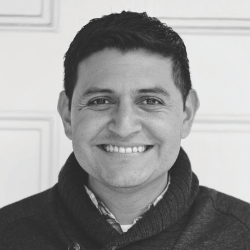
As a first-generation Latino1 pastor who migrated to the United States from Costa Rica, I have found in Latino ministry one of my deepest pastoral concerns and theological reflections: the identity formation of our Latino youth as both Latinos and followers of Jesus Christ. I find solace in the fact that other immigrant communities and churches struggle with similar questions. Here I offer my “latinidad”2 as a conversation partner with other leaders committed to ministering with this generation of ethnic minority youth.3 The following observations stem from specific dynamics within the Latina reality, with the hope that they may mirror common themes present in the context of other ethnic groups.
As Latino and other minority young people wrestle with their identity, leaders can best journey alongside them by helping them navigate a hyphenated reality, creating shared spaces for storytelling, and naming systemic factors that impact their lives. In honoring the interplay of these three elements, a church community can be part of enabling a young person to know how he or she is made in God’s image and how to serve as an agent of God’s kingdom.
NAVIGATING A HYPHENATED REALITY
No single category is capable of describing the complexities of identity formation for those who belong to an ethnic subgroup. In my experience working among Latino young people, they often find themselves caught between the message of the dominant culture, which promotes the self as a free agent (independent, autonomous, and private), and a more fluid, interdependent, relational, and embedded self defined by relationships and contexts.4 This experience also resonates with other ethnic minority youth, embodying this binary tension in what is often described as “living in the hyphen.” Whether that hyphen is Mexican-American, Korean-American, Thai-American, or Cuban-American, this expression attempts to capture the challenge of forming an identity that experiences the continual conflict between the values of individualism and collectivism, assimilation and acculturation, and dominant and ethnic culture. Thus an ethnic minority youth may experience the distress of not fully fitting in either context and having to face the daunting task of navigating the norms, verbal and nonverbal communication, relational structures, and even entertainment preferences of both contexts.
 At the same time, this constant navigation is also seen as an asset, since ethnic minority youth develop a higher level of “code-switching”: a skill necessary to move among multiple worlds, conversations, tasks, and languages. Hyphenated ethnic terms like “Asian-American” convey this expressed need: both cultures and worldviews are operating and influencing the way an ethnic minority youth acts and lives in this world.
At the same time, this constant navigation is also seen as an asset, since ethnic minority youth develop a higher level of “code-switching”: a skill necessary to move among multiple worlds, conversations, tasks, and languages. Hyphenated ethnic terms like “Asian-American” convey this expressed need: both cultures and worldviews are operating and influencing the way an ethnic minority youth acts and lives in this world.
My pastoral experience has shown me that bilingual ministries often embody this hyphenated reality. The use of both Spanish and English within a worship setting conveys the reality that Latino youth inhabit every day at home. Alma,5 one of our emerging Latina leaders, recently pointed out, “There are just certain things that I need to tell to God in Spanish; I must use Spanish. At other points in the service, English is the language that best allows me to connect with God.” Alma’s identity formation process can be embraced in the space between both languages. A bilingual gathering facilitates worship expressions that invite young people like Alma to connect to God without having to suppress one language in service to another.
CREATING SHARED SPACES FOR STORYTELLING
The importance of storytelling for ethnic minority youth came to life for me in a new way recently. Our congregation practices a monthly rhythm of gathering in homes, bringing dishes to share in a meal, and listening to one member share his or her story. We call this convivio, from the word convivencia, which means living with and being mutually transformed by one another. During one of my congregation’s convivios, I asked Nelson, a 15-year-old Mexican-American youth, to share his story with the gathering. Nelson told us his mother’s story of immigration to and deportation from the United States; the doctor’s diagnosis of encephalitis upon his birth; and his grandmother’s fervent and answered prayer for his healing. He then proceeded to thank God for God’s intervening grace and physical healing while at the same time bringing before God the recurring question, “How long before I am reunited with my mom?”
The congregation responded to Nelson’s story by reflecting back to him the specific ways they have witnessed God’s healing power in Nelson’s life, and came to share Nelson’s deepest longing to be united with his mom despite his undocumented status. After a time of prayer and affirmation for the gift that Nelson is to our community, he commented, “This is weird! Now you know all my secrets. You’re like family now!” The congregation needed to hear and witness his story, and Nelson needed to process, explain, and make meaning of his story in the midst of his community. Nelson would later tell me that on that day he felt affirmed, both as a Latino and as a follower of Christ. He did not need to hide the “shameful” parts of his story, but rather he began to realize that those were the places where God’s love was amplified.
A congregation that fosters safe spaces for young people to share their own or their families’ stories of immigration, oppression, and/or violence both in the youth group setting as well as with the entire congregation deeply impacts a young person’s identity formation process. The young person is not left to make meaning of his or her complex experiences alone, but is helped by the community to bring together what otherwise may seem like fragmented parts of the young person’s identity. This means that a church committed to God’s mission within and alongside ethnic minority youth must reconsider which narratives are being overlooked. At the same time, it must be ready to come alongside the young person to help him or her recognize and identify how God has intervened and been present in that young person’s familial and cultural story.
Helping young people tell their stories may take the form of intentionally accompanying a student as he or she creates an ethnic/ cultural autobiography6 through music, art, poetry, an essay, dance, film, or an alternative hands-on project. Ethnic minority youth, beyond their earnest desire for recognition and popularity in social media, long to be listened to, affirmed, and encouraged by a community that gives witness to their unique development as children of God. Beyond the “likes,” “comments,” or the number of “followers” they may have on social media, a person’s journey is always best explored, understood, and celebrated in face-to-face interactions in the life of a redemptive community: the church.
NAMING SYSTEMIC FACTORS
Another element that adds to the complexity of identity formation for ethnic minority youth is the reality of systems. Ministry at and within the margins must name the systems that interact and intersect with a young person’s understanding of self in relation to his or her community. As Elizabeth Conde-Frazier explains, the “ecological approach to the spiritual formation of youth” becomes crucial in identifying the social structures and networks that form and support the development of Latino/a adolescents.7 She describes a series of concentric circles, beginning with the young person in the center, moving out to the family, a local faith community, a local civic community, and culture.8 The role of a local faith community as it engages in all surrounding circles provides a tremendous impact upon the life of the young person so that both life-nurturing as well as life-oppressing systems are named, explored, and when necessary, condemned as countering the kingdom of God.9 Educational, policing, and economic systems in a community that tend to exclude our young people based on their color of skin, socioeconomic status, or zip code must be named as contrary to the gospel of Jesus Christ.
On the other hand, rites of passage—such as quinceañeras, local art, music and dance—as well as alternative economic support systems must be acknowledged as resonating with God’s heart for well being and justice. For example, I recall celebrating God’s provision after the fundraising efforts of the Barragan family as they sold homemade tacos to neighbors and friends for the funeral expenses of a family member in Mexico. Yet as we envision rites of passage that reflect God’s heart for justice, we must recognize and understand the impact that systemic factors have on our youth and their families before setting up programs that we assume will most impact their identity formation. We first need to take time to discern the spaces where the majority of their lives happen and where they are being formed and impacted as humans.
A practical step stemming from this observation is that leaders can drive, walk, or bike through the neighborhood alongside an ethnic minority youth so that the leader can see a community through a young per- son’s eyes and process together what they observe. It is extremely important to know where young people and their respective families live, play, shop, eat, and conduct business, for this is where they are being shaped the most in the intersection of various systems. During my first pastorate, I asked Mario, an 18-year-old former gang member, to take me to the most important part of the city. He took me to the swap meet. This particular swap meet embodied an alternative economic system within the city while also hosting entire family outings and recreational spaces. Ministering in this community with Latino youth taught me to always ask the question, “Where do families gather when they are not working? What are the informal gathering places for our youth and their respective families that speak to their systemic realities?” Leaders working with ethnic minority youth must take the time to understand these often invisible forces so they can help young people navigate them more explicitly as part of their identity formation process as children of God.
This discussion of a hyphenated reality, shared spaces for storytelling, and the naming of systems provides just an initial introduction into the factors influencing the formation process of ethnic minority youth. But these factors can serve as helpful front doors through which to enter into a young person’s reality and begin walking alongside him or her on this journey. As the United States continues to move toward an increasingly multicultural society, the fostering of identity formation among ethnic minority youth will be an imperative for the church.
As a Latino pastor, I am aware that it is crucial for our congregation to affirm our emerging leaders’ bilingual identity and bicultural gifts so they are able to minister not just within the Latina church, but also beyond it. I love dreaming with young people, their parents, and the rest of the congregation not just about how our youth can under- stand their bicultural world, but also how they can help shape it.


